Information Systems and Big Data Analysis: Definitions and Impact
VerifiedAdded on 2023/06/10
|11
|3228
|232
Report
AI Summary
This report delves into the realm of big data and information systems, providing definitions for essential terms like Moodle, MS Office, DSS, ESS, TPS, MIS, and KSM. It explores the significance of globalization and its effects on IT, highlighting its role in connecting businesses worldwide. The report examines digital infrastructure, outlining its advantages and disadvantages, and discusses the risks associated with information systems outsourcing. It also emphasizes the role of IT infrastructure in digital transformation, offering a comprehensive overview of these interconnected concepts. The report aims to provide a clear understanding of how these elements function within a business context, and how they impact on the global economy.
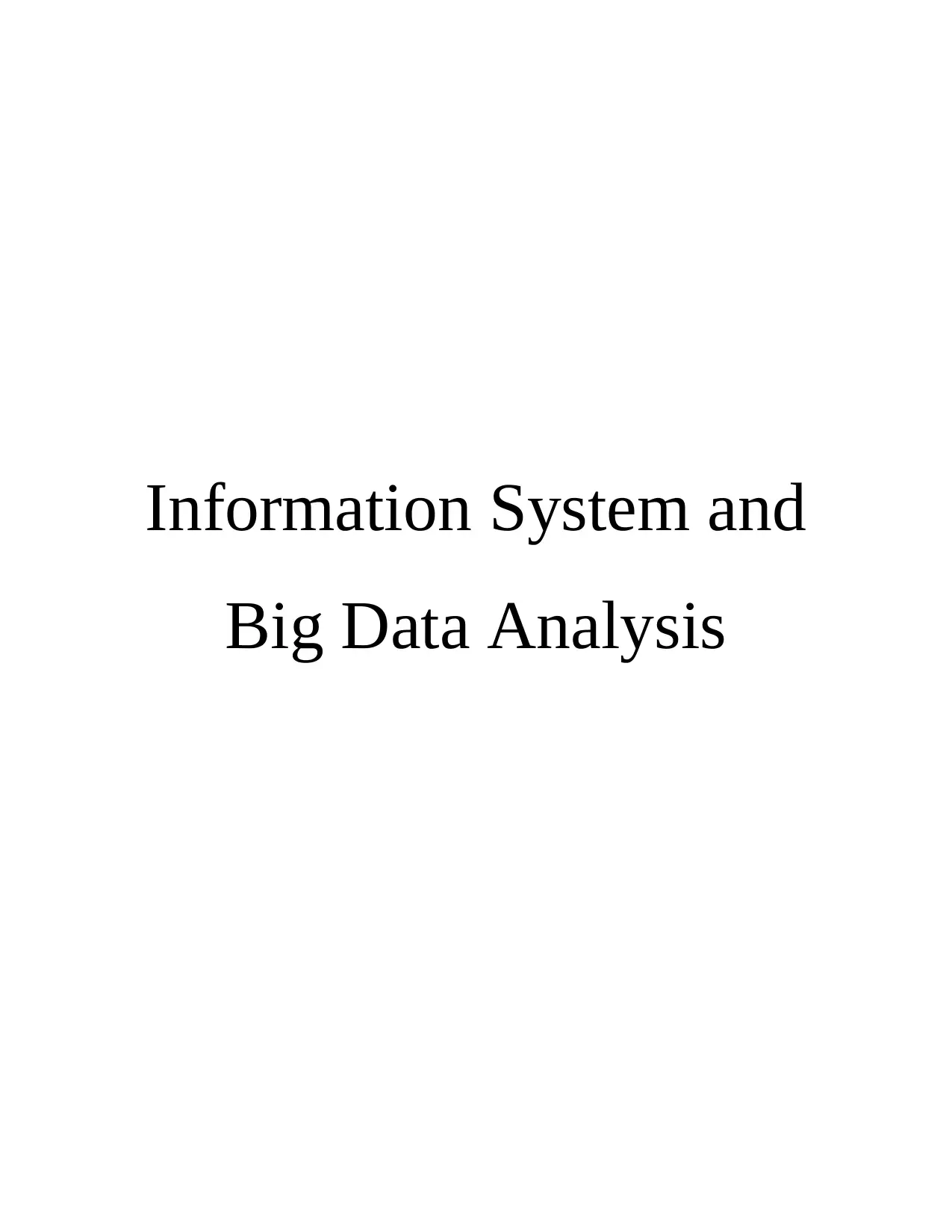
Information System and
Big Data Analysis
Big Data Analysis
Paraphrase This Document
Need a fresh take? Get an instant paraphrase of this document with our AI Paraphraser
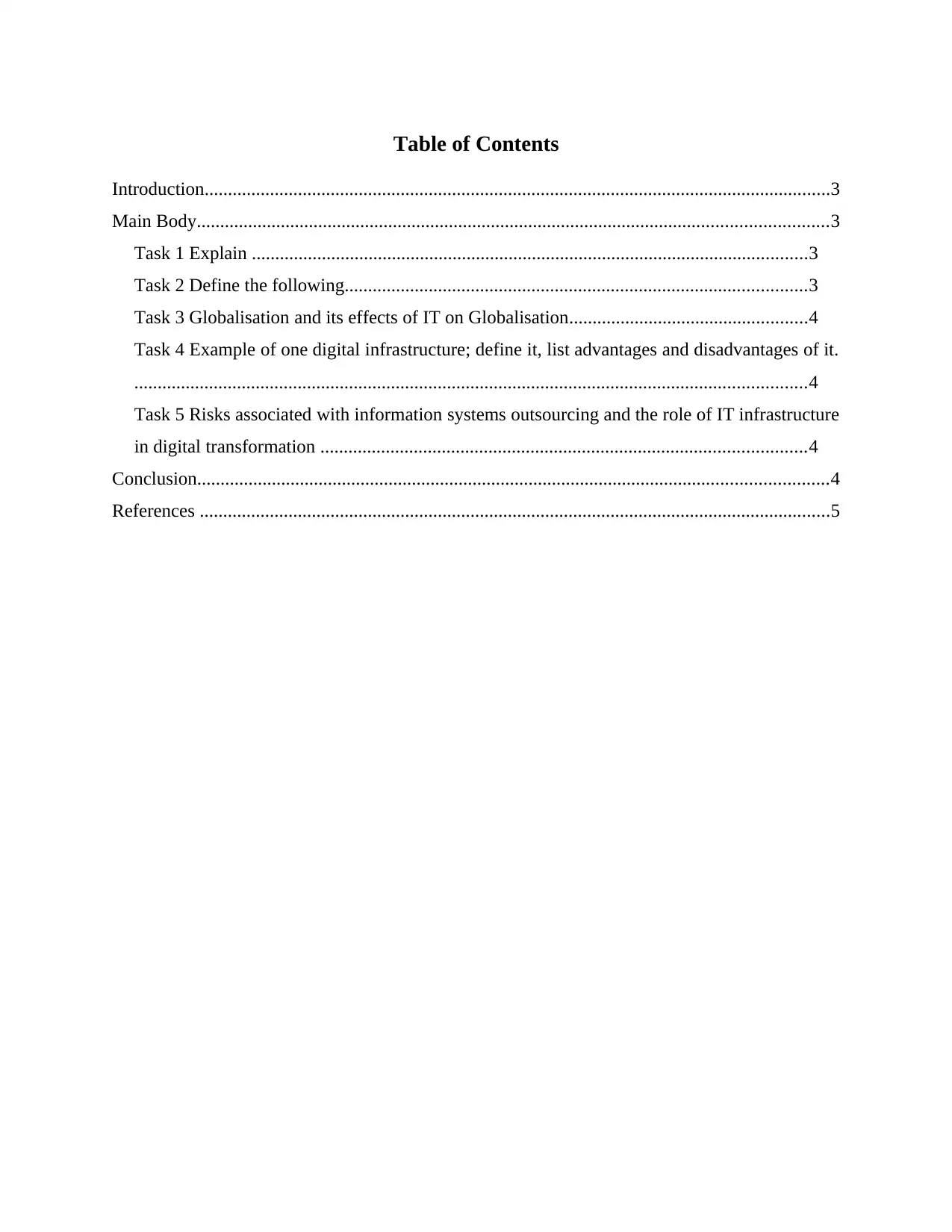
Table of Contents
Introduction......................................................................................................................................3
Main Body.......................................................................................................................................3
Task 1 Explain .......................................................................................................................3
Task 2 Define the following...................................................................................................3
Task 3 Globalisation and its effects of IT on Globalisation...................................................4
Task 4 Example of one digital infrastructure; define it, list advantages and disadvantages of it.
................................................................................................................................................4
Task 5 Risks associated with information systems outsourcing and the role of IT infrastructure
in digital transformation ........................................................................................................4
Conclusion.......................................................................................................................................4
References .......................................................................................................................................5
Introduction......................................................................................................................................3
Main Body.......................................................................................................................................3
Task 1 Explain .......................................................................................................................3
Task 2 Define the following...................................................................................................3
Task 3 Globalisation and its effects of IT on Globalisation...................................................4
Task 4 Example of one digital infrastructure; define it, list advantages and disadvantages of it.
................................................................................................................................................4
Task 5 Risks associated with information systems outsourcing and the role of IT infrastructure
in digital transformation ........................................................................................................4
Conclusion.......................................................................................................................................4
References .......................................................................................................................................5
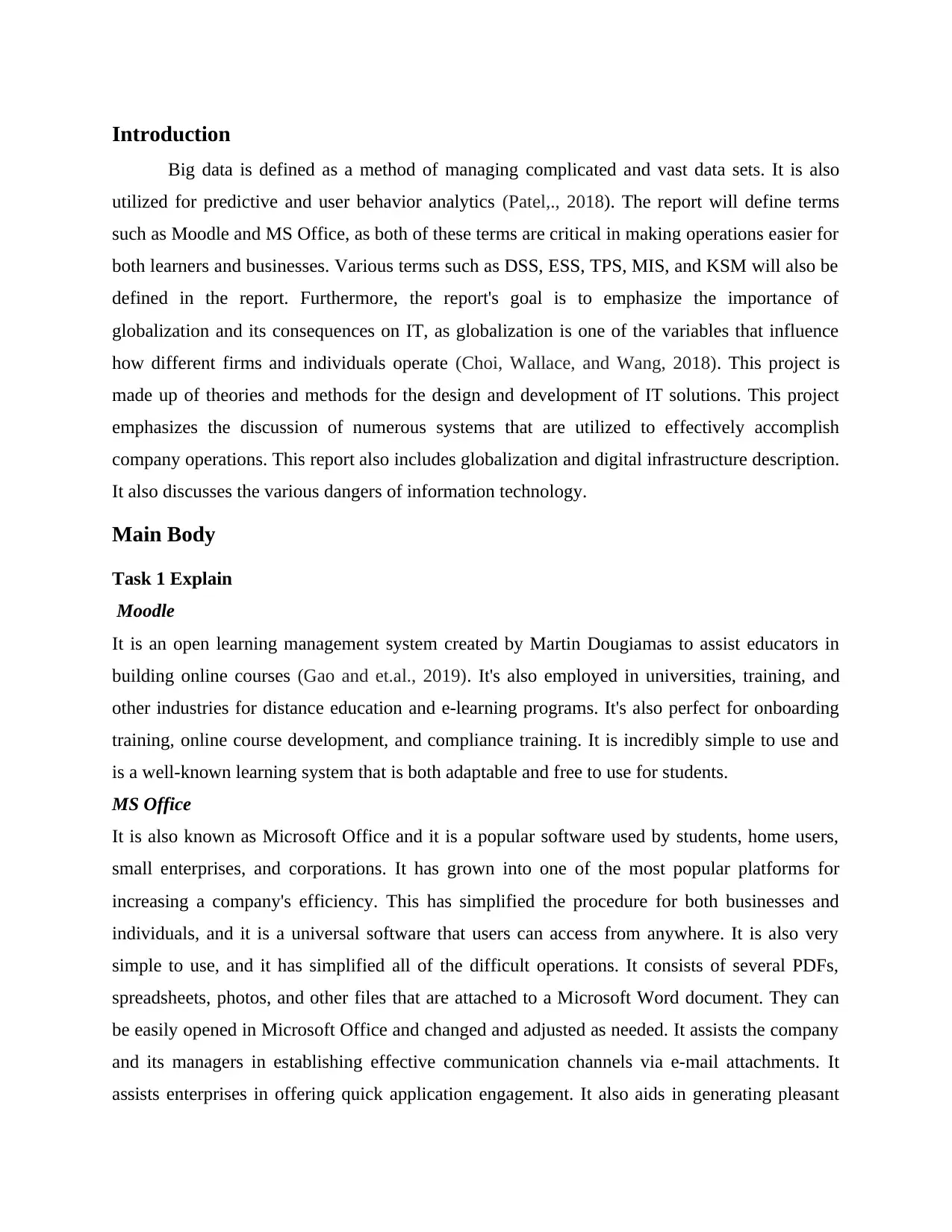
Introduction
Big data is defined as a method of managing complicated and vast data sets. It is also
utilized for predictive and user behavior analytics (Patel,., 2018). The report will define terms
such as Moodle and MS Office, as both of these terms are critical in making operations easier for
both learners and businesses. Various terms such as DSS, ESS, TPS, MIS, and KSM will also be
defined in the report. Furthermore, the report's goal is to emphasize the importance of
globalization and its consequences on IT, as globalization is one of the variables that influence
how different firms and individuals operate (Choi, Wallace, and Wang, 2018). This project is
made up of theories and methods for the design and development of IT solutions. This project
emphasizes the discussion of numerous systems that are utilized to effectively accomplish
company operations. This report also includes globalization and digital infrastructure description.
It also discusses the various dangers of information technology.
Main Body
Task 1 Explain
Moodle
It is an open learning management system created by Martin Dougiamas to assist educators in
building online courses (Gao and et.al., 2019). It's also employed in universities, training, and
other industries for distance education and e-learning programs. It's also perfect for onboarding
training, online course development, and compliance training. It is incredibly simple to use and
is a well-known learning system that is both adaptable and free to use for students.
MS Office
It is also known as Microsoft Office and it is a popular software used by students, home users,
small enterprises, and corporations. It has grown into one of the most popular platforms for
increasing a company's efficiency. This has simplified the procedure for both businesses and
individuals, and it is a universal software that users can access from anywhere. It is also very
simple to use, and it has simplified all of the difficult operations. It consists of several PDFs,
spreadsheets, photos, and other files that are attached to a Microsoft Word document. They can
be easily opened in Microsoft Office and changed and adjusted as needed. It assists the company
and its managers in establishing effective communication channels via e-mail attachments. It
assists enterprises in offering quick application engagement. It also aids in generating pleasant
Big data is defined as a method of managing complicated and vast data sets. It is also
utilized for predictive and user behavior analytics (Patel,., 2018). The report will define terms
such as Moodle and MS Office, as both of these terms are critical in making operations easier for
both learners and businesses. Various terms such as DSS, ESS, TPS, MIS, and KSM will also be
defined in the report. Furthermore, the report's goal is to emphasize the importance of
globalization and its consequences on IT, as globalization is one of the variables that influence
how different firms and individuals operate (Choi, Wallace, and Wang, 2018). This project is
made up of theories and methods for the design and development of IT solutions. This project
emphasizes the discussion of numerous systems that are utilized to effectively accomplish
company operations. This report also includes globalization and digital infrastructure description.
It also discusses the various dangers of information technology.
Main Body
Task 1 Explain
Moodle
It is an open learning management system created by Martin Dougiamas to assist educators in
building online courses (Gao and et.al., 2019). It's also employed in universities, training, and
other industries for distance education and e-learning programs. It's also perfect for onboarding
training, online course development, and compliance training. It is incredibly simple to use and
is a well-known learning system that is both adaptable and free to use for students.
MS Office
It is also known as Microsoft Office and it is a popular software used by students, home users,
small enterprises, and corporations. It has grown into one of the most popular platforms for
increasing a company's efficiency. This has simplified the procedure for both businesses and
individuals, and it is a universal software that users can access from anywhere. It is also very
simple to use, and it has simplified all of the difficult operations. It consists of several PDFs,
spreadsheets, photos, and other files that are attached to a Microsoft Word document. They can
be easily opened in Microsoft Office and changed and adjusted as needed. It assists the company
and its managers in establishing effective communication channels via e-mail attachments. It
assists enterprises in offering quick application engagement. It also aids in generating pleasant
⊘ This is a preview!⊘
Do you want full access?
Subscribe today to unlock all pages.

Trusted by 1+ million students worldwide
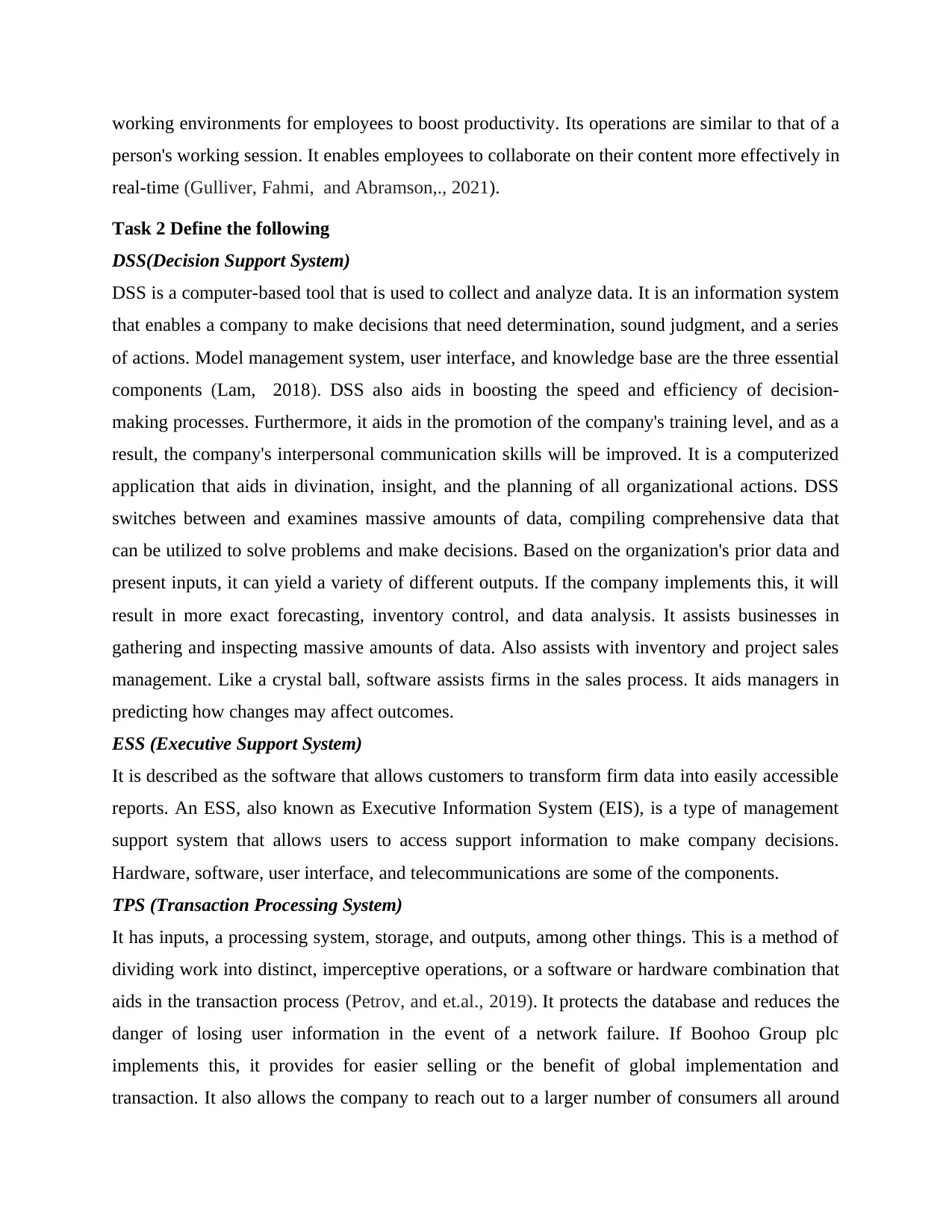
working environments for employees to boost productivity. Its operations are similar to that of a
person's working session. It enables employees to collaborate on their content more effectively in
real-time (Gulliver, Fahmi, and Abramson,., 2021).
Task 2 Define the following
DSS(Decision Support System)
DSS is a computer-based tool that is used to collect and analyze data. It is an information system
that enables a company to make decisions that need determination, sound judgment, and a series
of actions. Model management system, user interface, and knowledge base are the three essential
components (Lam, 2018). DSS also aids in boosting the speed and efficiency of decision-
making processes. Furthermore, it aids in the promotion of the company's training level, and as a
result, the company's interpersonal communication skills will be improved. It is a computerized
application that aids in divination, insight, and the planning of all organizational actions. DSS
switches between and examines massive amounts of data, compiling comprehensive data that
can be utilized to solve problems and make decisions. Based on the organization's prior data and
present inputs, it can yield a variety of different outputs. If the company implements this, it will
result in more exact forecasting, inventory control, and data analysis. It assists businesses in
gathering and inspecting massive amounts of data. Also assists with inventory and project sales
management. Like a crystal ball, software assists firms in the sales process. It aids managers in
predicting how changes may affect outcomes.
ESS (Executive Support System)
It is described as the software that allows customers to transform firm data into easily accessible
reports. An ESS, also known as Executive Information System (EIS), is a type of management
support system that allows users to access support information to make company decisions.
Hardware, software, user interface, and telecommunications are some of the components.
TPS (Transaction Processing System)
It has inputs, a processing system, storage, and outputs, among other things. This is a method of
dividing work into distinct, imperceptive operations, or a software or hardware combination that
aids in the transaction process (Petrov, and et.al., 2019). It protects the database and reduces the
danger of losing user information in the event of a network failure. If Boohoo Group plc
implements this, it provides for easier selling or the benefit of global implementation and
transaction. It also allows the company to reach out to a larger number of consumers all around
person's working session. It enables employees to collaborate on their content more effectively in
real-time (Gulliver, Fahmi, and Abramson,., 2021).
Task 2 Define the following
DSS(Decision Support System)
DSS is a computer-based tool that is used to collect and analyze data. It is an information system
that enables a company to make decisions that need determination, sound judgment, and a series
of actions. Model management system, user interface, and knowledge base are the three essential
components (Lam, 2018). DSS also aids in boosting the speed and efficiency of decision-
making processes. Furthermore, it aids in the promotion of the company's training level, and as a
result, the company's interpersonal communication skills will be improved. It is a computerized
application that aids in divination, insight, and the planning of all organizational actions. DSS
switches between and examines massive amounts of data, compiling comprehensive data that
can be utilized to solve problems and make decisions. Based on the organization's prior data and
present inputs, it can yield a variety of different outputs. If the company implements this, it will
result in more exact forecasting, inventory control, and data analysis. It assists businesses in
gathering and inspecting massive amounts of data. Also assists with inventory and project sales
management. Like a crystal ball, software assists firms in the sales process. It aids managers in
predicting how changes may affect outcomes.
ESS (Executive Support System)
It is described as the software that allows customers to transform firm data into easily accessible
reports. An ESS, also known as Executive Information System (EIS), is a type of management
support system that allows users to access support information to make company decisions.
Hardware, software, user interface, and telecommunications are some of the components.
TPS (Transaction Processing System)
It has inputs, a processing system, storage, and outputs, among other things. This is a method of
dividing work into distinct, imperceptive operations, or a software or hardware combination that
aids in the transaction process (Petrov, and et.al., 2019). It protects the database and reduces the
danger of losing user information in the event of a network failure. If Boohoo Group plc
implements this, it provides for easier selling or the benefit of global implementation and
transaction. It also allows the company to reach out to a larger number of consumers all around
Paraphrase This Document
Need a fresh take? Get an instant paraphrase of this document with our AI Paraphraser
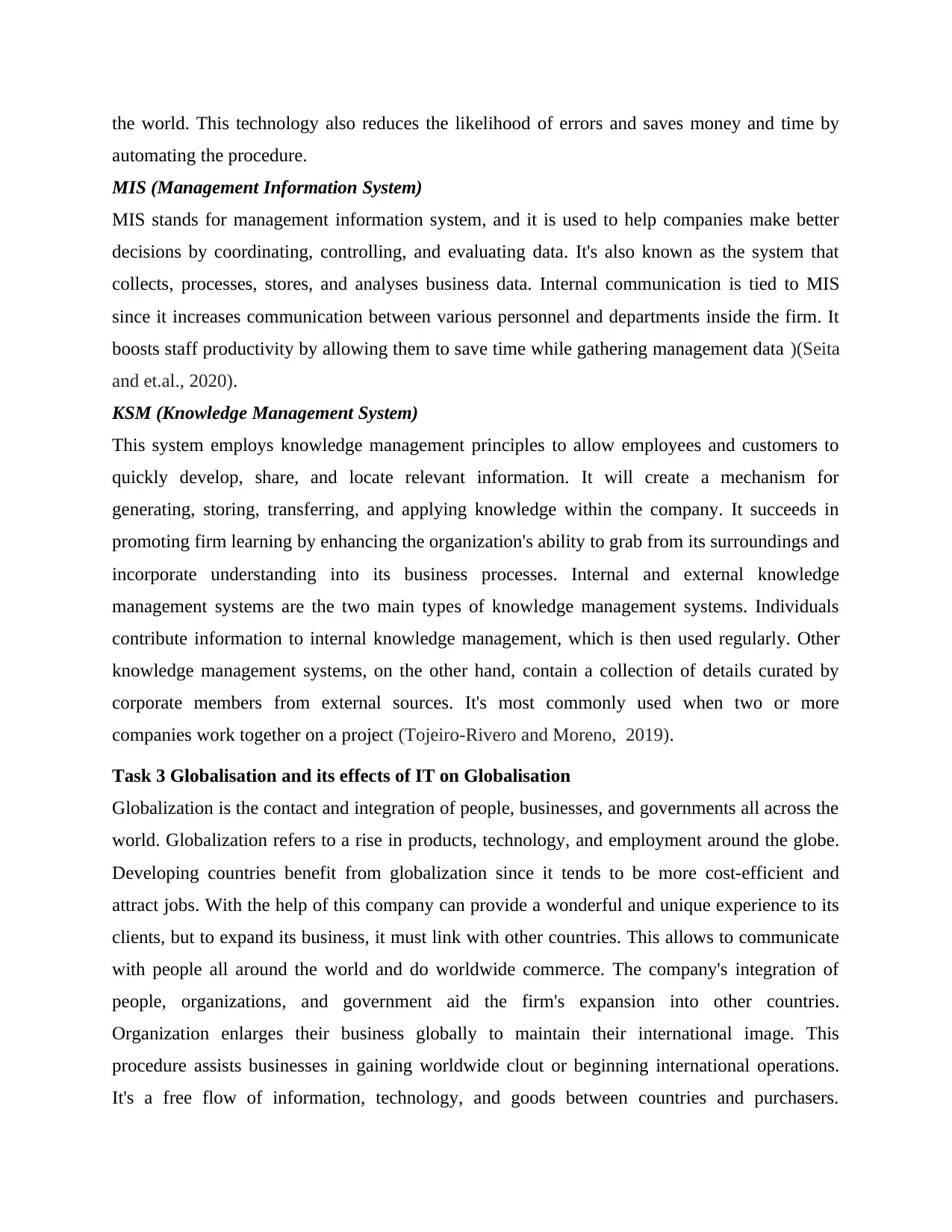
the world. This technology also reduces the likelihood of errors and saves money and time by
automating the procedure.
MIS (Management Information System)
MIS stands for management information system, and it is used to help companies make better
decisions by coordinating, controlling, and evaluating data. It's also known as the system that
collects, processes, stores, and analyses business data. Internal communication is tied to MIS
since it increases communication between various personnel and departments inside the firm. It
boosts staff productivity by allowing them to save time while gathering management data )(Seita
and et.al., 2020).
KSM (Knowledge Management System)
This system employs knowledge management principles to allow employees and customers to
quickly develop, share, and locate relevant information. It will create a mechanism for
generating, storing, transferring, and applying knowledge within the company. It succeeds in
promoting firm learning by enhancing the organization's ability to grab from its surroundings and
incorporate understanding into its business processes. Internal and external knowledge
management systems are the two main types of knowledge management systems. Individuals
contribute information to internal knowledge management, which is then used regularly. Other
knowledge management systems, on the other hand, contain a collection of details curated by
corporate members from external sources. It's most commonly used when two or more
companies work together on a project (Tojeiro-Rivero and Moreno, 2019).
Task 3 Globalisation and its effects of IT on Globalisation
Globalization is the contact and integration of people, businesses, and governments all across the
world. Globalization refers to a rise in products, technology, and employment around the globe.
Developing countries benefit from globalization since it tends to be more cost-efficient and
attract jobs. With the help of this company can provide a wonderful and unique experience to its
clients, but to expand its business, it must link with other countries. This allows to communicate
with people all around the world and do worldwide commerce. The company's integration of
people, organizations, and government aid the firm's expansion into other countries.
Organization enlarges their business globally to maintain their international image. This
procedure assists businesses in gaining worldwide clout or beginning international operations.
It's a free flow of information, technology, and goods between countries and purchasers.
automating the procedure.
MIS (Management Information System)
MIS stands for management information system, and it is used to help companies make better
decisions by coordinating, controlling, and evaluating data. It's also known as the system that
collects, processes, stores, and analyses business data. Internal communication is tied to MIS
since it increases communication between various personnel and departments inside the firm. It
boosts staff productivity by allowing them to save time while gathering management data )(Seita
and et.al., 2020).
KSM (Knowledge Management System)
This system employs knowledge management principles to allow employees and customers to
quickly develop, share, and locate relevant information. It will create a mechanism for
generating, storing, transferring, and applying knowledge within the company. It succeeds in
promoting firm learning by enhancing the organization's ability to grab from its surroundings and
incorporate understanding into its business processes. Internal and external knowledge
management systems are the two main types of knowledge management systems. Individuals
contribute information to internal knowledge management, which is then used regularly. Other
knowledge management systems, on the other hand, contain a collection of details curated by
corporate members from external sources. It's most commonly used when two or more
companies work together on a project (Tojeiro-Rivero and Moreno, 2019).
Task 3 Globalisation and its effects of IT on Globalisation
Globalization is the contact and integration of people, businesses, and governments all across the
world. Globalization refers to a rise in products, technology, and employment around the globe.
Developing countries benefit from globalization since it tends to be more cost-efficient and
attract jobs. With the help of this company can provide a wonderful and unique experience to its
clients, but to expand its business, it must link with other countries. This allows to communicate
with people all around the world and do worldwide commerce. The company's integration of
people, organizations, and government aid the firm's expansion into other countries.
Organization enlarges their business globally to maintain their international image. This
procedure assists businesses in gaining worldwide clout or beginning international operations.
It's a free flow of information, technology, and goods between countries and purchasers.
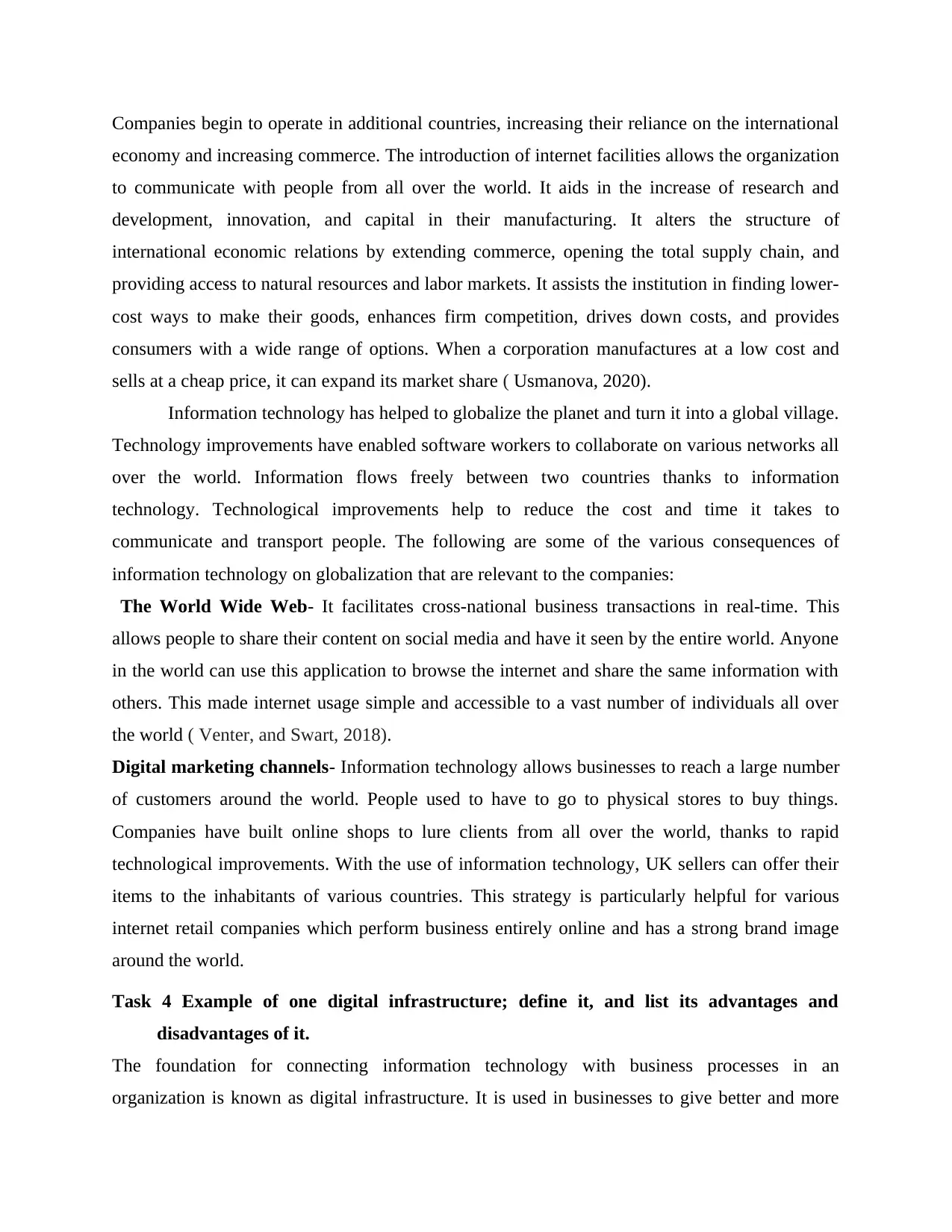
Companies begin to operate in additional countries, increasing their reliance on the international
economy and increasing commerce. The introduction of internet facilities allows the organization
to communicate with people from all over the world. It aids in the increase of research and
development, innovation, and capital in their manufacturing. It alters the structure of
international economic relations by extending commerce, opening the total supply chain, and
providing access to natural resources and labor markets. It assists the institution in finding lower-
cost ways to make their goods, enhances firm competition, drives down costs, and provides
consumers with a wide range of options. When a corporation manufactures at a low cost and
sells at a cheap price, it can expand its market share ( Usmanova, 2020).
Information technology has helped to globalize the planet and turn it into a global village.
Technology improvements have enabled software workers to collaborate on various networks all
over the world. Information flows freely between two countries thanks to information
technology. Technological improvements help to reduce the cost and time it takes to
communicate and transport people. The following are some of the various consequences of
information technology on globalization that are relevant to the companies:
The World Wide Web- It facilitates cross-national business transactions in real-time. This
allows people to share their content on social media and have it seen by the entire world. Anyone
in the world can use this application to browse the internet and share the same information with
others. This made internet usage simple and accessible to a vast number of individuals all over
the world ( Venter, and Swart, 2018).
Digital marketing channels- Information technology allows businesses to reach a large number
of customers around the world. People used to have to go to physical stores to buy things.
Companies have built online shops to lure clients from all over the world, thanks to rapid
technological improvements. With the use of information technology, UK sellers can offer their
items to the inhabitants of various countries. This strategy is particularly helpful for various
internet retail companies which perform business entirely online and has a strong brand image
around the world.
Task 4 Example of one digital infrastructure; define it, and list its advantages and
disadvantages of it.
The foundation for connecting information technology with business processes in an
organization is known as digital infrastructure. It is used in businesses to give better and more
economy and increasing commerce. The introduction of internet facilities allows the organization
to communicate with people from all over the world. It aids in the increase of research and
development, innovation, and capital in their manufacturing. It alters the structure of
international economic relations by extending commerce, opening the total supply chain, and
providing access to natural resources and labor markets. It assists the institution in finding lower-
cost ways to make their goods, enhances firm competition, drives down costs, and provides
consumers with a wide range of options. When a corporation manufactures at a low cost and
sells at a cheap price, it can expand its market share ( Usmanova, 2020).
Information technology has helped to globalize the planet and turn it into a global village.
Technology improvements have enabled software workers to collaborate on various networks all
over the world. Information flows freely between two countries thanks to information
technology. Technological improvements help to reduce the cost and time it takes to
communicate and transport people. The following are some of the various consequences of
information technology on globalization that are relevant to the companies:
The World Wide Web- It facilitates cross-national business transactions in real-time. This
allows people to share their content on social media and have it seen by the entire world. Anyone
in the world can use this application to browse the internet and share the same information with
others. This made internet usage simple and accessible to a vast number of individuals all over
the world ( Venter, and Swart, 2018).
Digital marketing channels- Information technology allows businesses to reach a large number
of customers around the world. People used to have to go to physical stores to buy things.
Companies have built online shops to lure clients from all over the world, thanks to rapid
technological improvements. With the use of information technology, UK sellers can offer their
items to the inhabitants of various countries. This strategy is particularly helpful for various
internet retail companies which perform business entirely online and has a strong brand image
around the world.
Task 4 Example of one digital infrastructure; define it, and list its advantages and
disadvantages of it.
The foundation for connecting information technology with business processes in an
organization is known as digital infrastructure. It is used in businesses to give better and more
⊘ This is a preview!⊘
Do you want full access?
Subscribe today to unlock all pages.

Trusted by 1+ million students worldwide
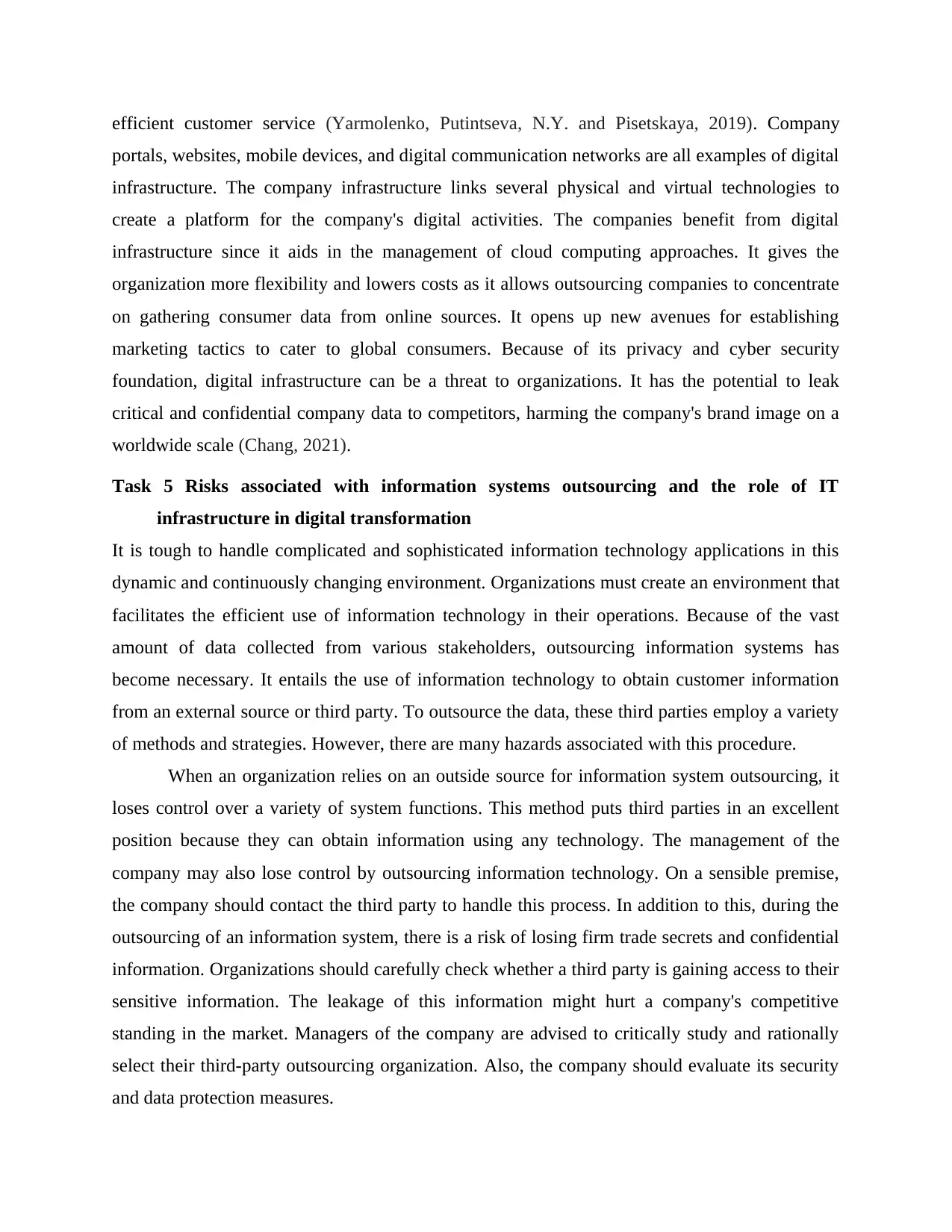
efficient customer service (Yarmolenko, Putintseva, N.Y. and Pisetskaya, 2019). Company
portals, websites, mobile devices, and digital communication networks are all examples of digital
infrastructure. The company infrastructure links several physical and virtual technologies to
create a platform for the company's digital activities. The companies benefit from digital
infrastructure since it aids in the management of cloud computing approaches. It gives the
organization more flexibility and lowers costs as it allows outsourcing companies to concentrate
on gathering consumer data from online sources. It opens up new avenues for establishing
marketing tactics to cater to global consumers. Because of its privacy and cyber security
foundation, digital infrastructure can be a threat to organizations. It has the potential to leak
critical and confidential company data to competitors, harming the company's brand image on a
worldwide scale (Chang, 2021).
Task 5 Risks associated with information systems outsourcing and the role of IT
infrastructure in digital transformation
It is tough to handle complicated and sophisticated information technology applications in this
dynamic and continuously changing environment. Organizations must create an environment that
facilitates the efficient use of information technology in their operations. Because of the vast
amount of data collected from various stakeholders, outsourcing information systems has
become necessary. It entails the use of information technology to obtain customer information
from an external source or third party. To outsource the data, these third parties employ a variety
of methods and strategies. However, there are many hazards associated with this procedure.
When an organization relies on an outside source for information system outsourcing, it
loses control over a variety of system functions. This method puts third parties in an excellent
position because they can obtain information using any technology. The management of the
company may also lose control by outsourcing information technology. On a sensible premise,
the company should contact the third party to handle this process. In addition to this, during the
outsourcing of an information system, there is a risk of losing firm trade secrets and confidential
information. Organizations should carefully check whether a third party is gaining access to their
sensitive information. The leakage of this information might hurt a company's competitive
standing in the market. Managers of the company are advised to critically study and rationally
select their third-party outsourcing organization. Also, the company should evaluate its security
and data protection measures.
portals, websites, mobile devices, and digital communication networks are all examples of digital
infrastructure. The company infrastructure links several physical and virtual technologies to
create a platform for the company's digital activities. The companies benefit from digital
infrastructure since it aids in the management of cloud computing approaches. It gives the
organization more flexibility and lowers costs as it allows outsourcing companies to concentrate
on gathering consumer data from online sources. It opens up new avenues for establishing
marketing tactics to cater to global consumers. Because of its privacy and cyber security
foundation, digital infrastructure can be a threat to organizations. It has the potential to leak
critical and confidential company data to competitors, harming the company's brand image on a
worldwide scale (Chang, 2021).
Task 5 Risks associated with information systems outsourcing and the role of IT
infrastructure in digital transformation
It is tough to handle complicated and sophisticated information technology applications in this
dynamic and continuously changing environment. Organizations must create an environment that
facilitates the efficient use of information technology in their operations. Because of the vast
amount of data collected from various stakeholders, outsourcing information systems has
become necessary. It entails the use of information technology to obtain customer information
from an external source or third party. To outsource the data, these third parties employ a variety
of methods and strategies. However, there are many hazards associated with this procedure.
When an organization relies on an outside source for information system outsourcing, it
loses control over a variety of system functions. This method puts third parties in an excellent
position because they can obtain information using any technology. The management of the
company may also lose control by outsourcing information technology. On a sensible premise,
the company should contact the third party to handle this process. In addition to this, during the
outsourcing of an information system, there is a risk of losing firm trade secrets and confidential
information. Organizations should carefully check whether a third party is gaining access to their
sensitive information. The leakage of this information might hurt a company's competitive
standing in the market. Managers of the company are advised to critically study and rationally
select their third-party outsourcing organization. Also, the company should evaluate its security
and data protection measures.
Paraphrase This Document
Need a fresh take? Get an instant paraphrase of this document with our AI Paraphraser
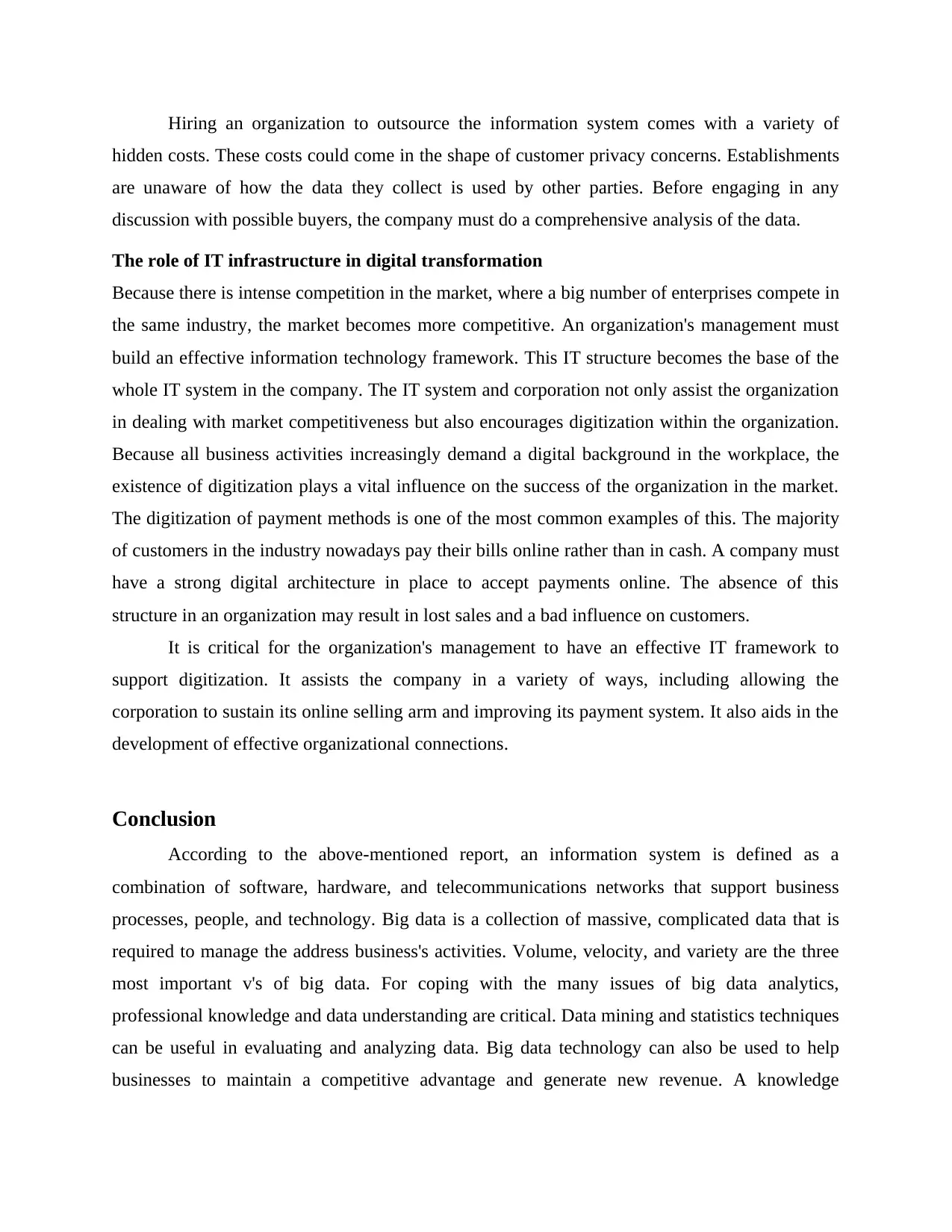
Hiring an organization to outsource the information system comes with a variety of
hidden costs. These costs could come in the shape of customer privacy concerns. Establishments
are unaware of how the data they collect is used by other parties. Before engaging in any
discussion with possible buyers, the company must do a comprehensive analysis of the data.
The role of IT infrastructure in digital transformation
Because there is intense competition in the market, where a big number of enterprises compete in
the same industry, the market becomes more competitive. An organization's management must
build an effective information technology framework. This IT structure becomes the base of the
whole IT system in the company. The IT system and corporation not only assist the organization
in dealing with market competitiveness but also encourages digitization within the organization.
Because all business activities increasingly demand a digital background in the workplace, the
existence of digitization plays a vital influence on the success of the organization in the market.
The digitization of payment methods is one of the most common examples of this. The majority
of customers in the industry nowadays pay their bills online rather than in cash. A company must
have a strong digital architecture in place to accept payments online. The absence of this
structure in an organization may result in lost sales and a bad influence on customers.
It is critical for the organization's management to have an effective IT framework to
support digitization. It assists the company in a variety of ways, including allowing the
corporation to sustain its online selling arm and improving its payment system. It also aids in the
development of effective organizational connections.
Conclusion
According to the above-mentioned report, an information system is defined as a
combination of software, hardware, and telecommunications networks that support business
processes, people, and technology. Big data is a collection of massive, complicated data that is
required to manage the address business's activities. Volume, velocity, and variety are the three
most important v's of big data. For coping with the many issues of big data analytics,
professional knowledge and data understanding are critical. Data mining and statistics techniques
can be useful in evaluating and analyzing data. Big data technology can also be used to help
businesses to maintain a competitive advantage and generate new revenue. A knowledge
hidden costs. These costs could come in the shape of customer privacy concerns. Establishments
are unaware of how the data they collect is used by other parties. Before engaging in any
discussion with possible buyers, the company must do a comprehensive analysis of the data.
The role of IT infrastructure in digital transformation
Because there is intense competition in the market, where a big number of enterprises compete in
the same industry, the market becomes more competitive. An organization's management must
build an effective information technology framework. This IT structure becomes the base of the
whole IT system in the company. The IT system and corporation not only assist the organization
in dealing with market competitiveness but also encourages digitization within the organization.
Because all business activities increasingly demand a digital background in the workplace, the
existence of digitization plays a vital influence on the success of the organization in the market.
The digitization of payment methods is one of the most common examples of this. The majority
of customers in the industry nowadays pay their bills online rather than in cash. A company must
have a strong digital architecture in place to accept payments online. The absence of this
structure in an organization may result in lost sales and a bad influence on customers.
It is critical for the organization's management to have an effective IT framework to
support digitization. It assists the company in a variety of ways, including allowing the
corporation to sustain its online selling arm and improving its payment system. It also aids in the
development of effective organizational connections.
Conclusion
According to the above-mentioned report, an information system is defined as a
combination of software, hardware, and telecommunications networks that support business
processes, people, and technology. Big data is a collection of massive, complicated data that is
required to manage the address business's activities. Volume, velocity, and variety are the three
most important v's of big data. For coping with the many issues of big data analytics,
professional knowledge and data understanding are critical. Data mining and statistics techniques
can be useful in evaluating and analyzing data. Big data technology can also be used to help
businesses to maintain a competitive advantage and generate new revenue. A knowledge

management system is an information technology platform that assists in getting the correct
information to the right people at the right time. This enables the structure to store and transfer
data in a manner that is consistent with an organization's strategic objectives. Globalization
allows businesses to connect with individuals all over the world, resulting in global culture,
regulations, and economic integration.
information to the right people at the right time. This enables the structure to store and transfer
data in a manner that is consistent with an organization's strategic objectives. Globalization
allows businesses to connect with individuals all over the world, resulting in global culture,
regulations, and economic integration.
⊘ This is a preview!⊘
Do you want full access?
Subscribe today to unlock all pages.

Trusted by 1+ million students worldwide
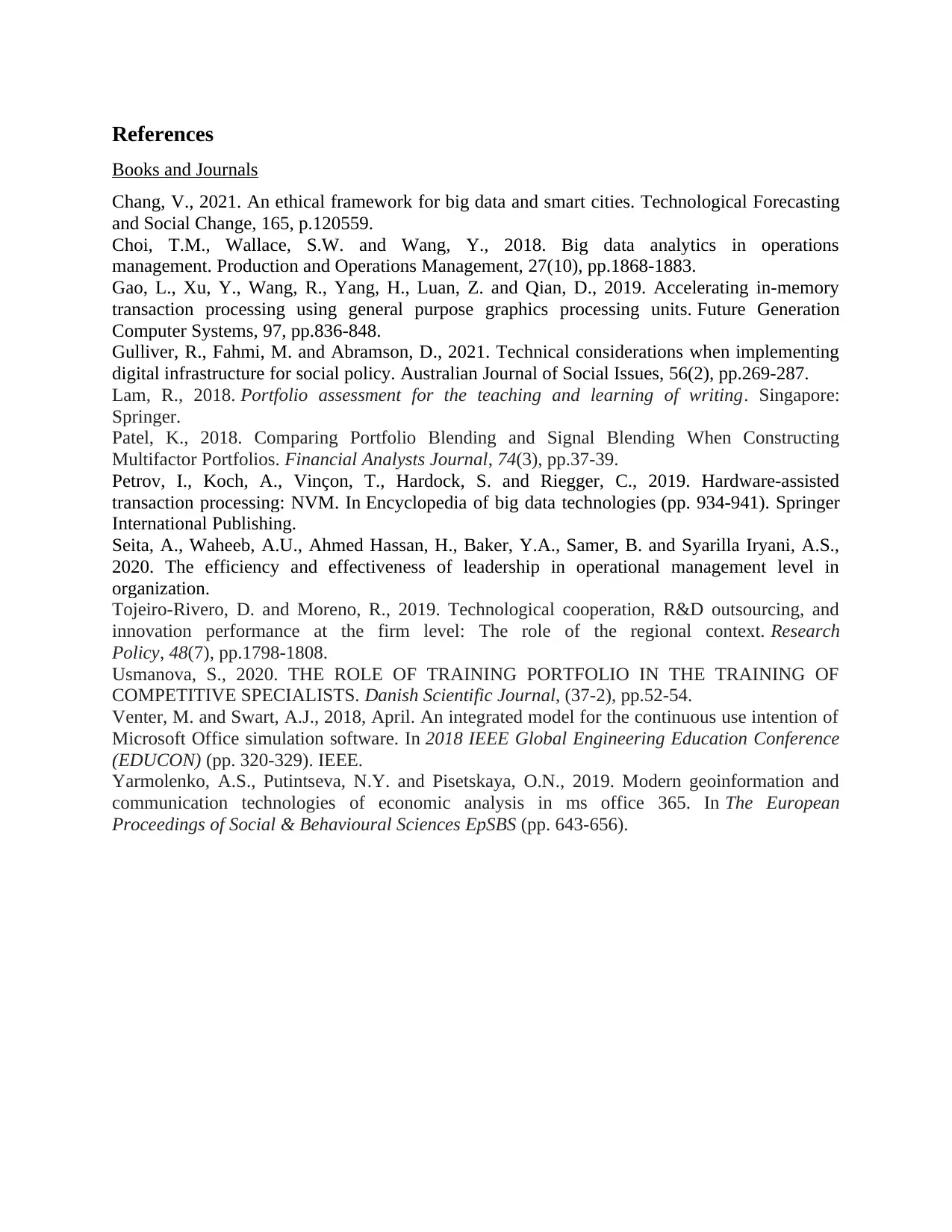
References
Books and Journals
Chang, V., 2021. An ethical framework for big data and smart cities. Technological Forecasting
and Social Change, 165, p.120559.
Choi, T.M., Wallace, S.W. and Wang, Y., 2018. Big data analytics in operations
management. Production and Operations Management, 27(10), pp.1868-1883.
Gao, L., Xu, Y., Wang, R., Yang, H., Luan, Z. and Qian, D., 2019. Accelerating in-memory
transaction processing using general purpose graphics processing units. Future Generation
Computer Systems, 97, pp.836-848.
Gulliver, R., Fahmi, M. and Abramson, D., 2021. Technical considerations when implementing
digital infrastructure for social policy. Australian Journal of Social Issues, 56(2), pp.269-287.
Lam, R., 2018. Portfolio assessment for the teaching and learning of writing. Singapore:
Springer.
Patel, K., 2018. Comparing Portfolio Blending and Signal Blending When Constructing
Multifactor Portfolios. Financial Analysts Journal, 74(3), pp.37-39.
Petrov, I., Koch, A., Vinçon, T., Hardock, S. and Riegger, C., 2019. Hardware-assisted
transaction processing: NVM. In Encyclopedia of big data technologies (pp. 934-941). Springer
International Publishing.
Seita, A., Waheeb, A.U., Ahmed Hassan, H., Baker, Y.A., Samer, B. and Syarilla Iryani, A.S.,
2020. The efficiency and effectiveness of leadership in operational management level in
organization.
Tojeiro-Rivero, D. and Moreno, R., 2019. Technological cooperation, R&D outsourcing, and
innovation performance at the firm level: The role of the regional context. Research
Policy, 48(7), pp.1798-1808.
Usmanova, S., 2020. THE ROLE OF TRAINING PORTFOLIO IN THE TRAINING OF
COMPETITIVE SPECIALISTS. Danish Scientific Journal, (37-2), pp.52-54.
Venter, M. and Swart, A.J., 2018, April. An integrated model for the continuous use intention of
Microsoft Office simulation software. In 2018 IEEE Global Engineering Education Conference
(EDUCON) (pp. 320-329). IEEE.
Yarmolenko, A.S., Putintseva, N.Y. and Pisetskaya, O.N., 2019. Modern geoinformation and
communication technologies of economic analysis in ms office 365. In The European
Proceedings of Social & Behavioural Sciences EpSBS (pp. 643-656).
Books and Journals
Chang, V., 2021. An ethical framework for big data and smart cities. Technological Forecasting
and Social Change, 165, p.120559.
Choi, T.M., Wallace, S.W. and Wang, Y., 2018. Big data analytics in operations
management. Production and Operations Management, 27(10), pp.1868-1883.
Gao, L., Xu, Y., Wang, R., Yang, H., Luan, Z. and Qian, D., 2019. Accelerating in-memory
transaction processing using general purpose graphics processing units. Future Generation
Computer Systems, 97, pp.836-848.
Gulliver, R., Fahmi, M. and Abramson, D., 2021. Technical considerations when implementing
digital infrastructure for social policy. Australian Journal of Social Issues, 56(2), pp.269-287.
Lam, R., 2018. Portfolio assessment for the teaching and learning of writing. Singapore:
Springer.
Patel, K., 2018. Comparing Portfolio Blending and Signal Blending When Constructing
Multifactor Portfolios. Financial Analysts Journal, 74(3), pp.37-39.
Petrov, I., Koch, A., Vinçon, T., Hardock, S. and Riegger, C., 2019. Hardware-assisted
transaction processing: NVM. In Encyclopedia of big data technologies (pp. 934-941). Springer
International Publishing.
Seita, A., Waheeb, A.U., Ahmed Hassan, H., Baker, Y.A., Samer, B. and Syarilla Iryani, A.S.,
2020. The efficiency and effectiveness of leadership in operational management level in
organization.
Tojeiro-Rivero, D. and Moreno, R., 2019. Technological cooperation, R&D outsourcing, and
innovation performance at the firm level: The role of the regional context. Research
Policy, 48(7), pp.1798-1808.
Usmanova, S., 2020. THE ROLE OF TRAINING PORTFOLIO IN THE TRAINING OF
COMPETITIVE SPECIALISTS. Danish Scientific Journal, (37-2), pp.52-54.
Venter, M. and Swart, A.J., 2018, April. An integrated model for the continuous use intention of
Microsoft Office simulation software. In 2018 IEEE Global Engineering Education Conference
(EDUCON) (pp. 320-329). IEEE.
Yarmolenko, A.S., Putintseva, N.Y. and Pisetskaya, O.N., 2019. Modern geoinformation and
communication technologies of economic analysis in ms office 365. In The European
Proceedings of Social & Behavioural Sciences EpSBS (pp. 643-656).
Paraphrase This Document
Need a fresh take? Get an instant paraphrase of this document with our AI Paraphraser

1 out of 11
Related Documents
Your All-in-One AI-Powered Toolkit for Academic Success.
+13062052269
info@desklib.com
Available 24*7 on WhatsApp / Email
![[object Object]](/_next/static/media/star-bottom.7253800d.svg)
Unlock your academic potential
Copyright © 2020–2025 A2Z Services. All Rights Reserved. Developed and managed by ZUCOL.
